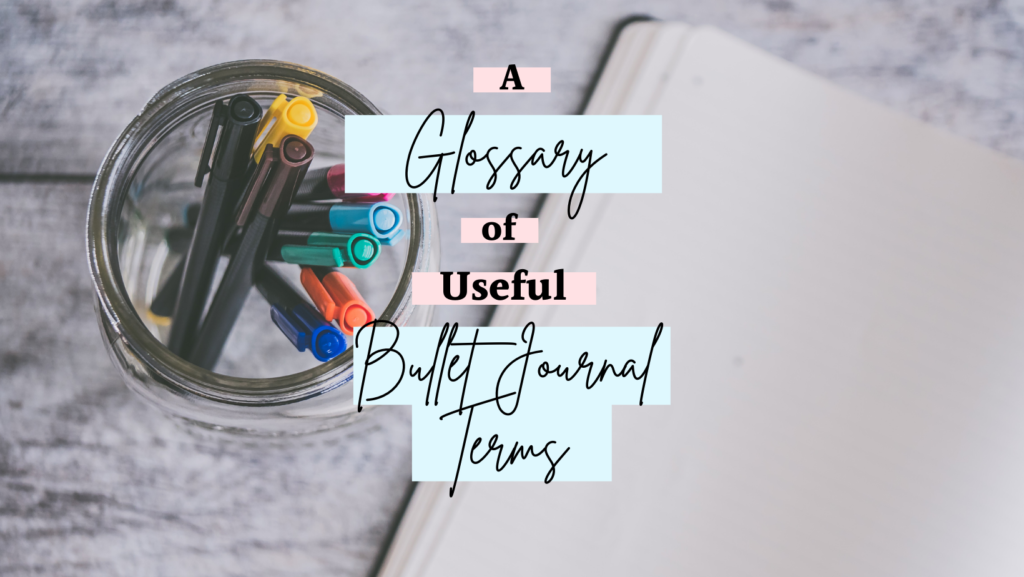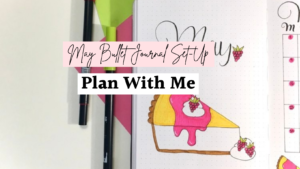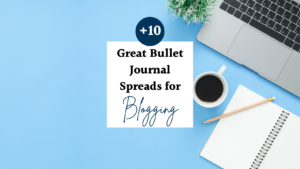Bullet Journaling can be complicated when you first start. There are lots of terms you need to know to be part of the bullet journaling community. It can feel like too many! But here are some of the bullet journal terms you need to know to start your bullet journaling experience!
Bullet Journal
A bullet journal is a paper journal used for organizing your schedule and your tasks. It typically has blank dotted paper so that the owner can create their spreads.
Dotted Journal
A dotted journal is a paper journal with dotted paper. The dots are intended to make creating lines and designs as easy as possible. Though lined paper and blank paper can be used for bullet journaling, dotted journals are the most commonly used.
Digital Journaling
Digital journaling is the equivalent of bullet journaling but uses apps and computer programs instead of paper journals. You can use your digital programs, like Canva, Procreate, or Photoshop, to create bullet journal spreads and collections.
Ryder Carroll’s Bullet Journal Method
Ryder Carroll is the original creator of the bullet journal method. His method consists of future logs, weekly logs, and daily logs. All of them are organized using bullet points, dashes and circles to indicate which are tasks, events, and notes.
Rapid Logging
Rapid logging is the basis of Ryder Carroll’s Bullet Journal Method. It is a short-hand communication used while bullet journaling. It involves using bullet points, dashes, and circles for tasks, notes, and events. They are crossed out to indicate when they are completed.
Alastair’s Method
Alastair’s Method is a newer bullet journal system that involves separating your tasks by categories, such as home, office, phone, etc. This method is great for keeping your tasks organized if you don’t like separating them by day.
Rolling Week
A variation of Alastair’s Method. The rolling week is a list where you can add all of your tasks to do for the week instead of separating them by day. It is a lesser-known alternative to Ryder Carroll’s weekly and daily logs.
Logs
Logs are what you call your to-do lists. They are the records of all you needed to do and all that you got done, whether it is for the day, week, month, or year.
Spreads
Spreads are a newer term for all the pages you add to your bullet journal. Every coherent page or group of pages is considered a spread. If you use one page for your calendar, it is considered a spread. But If you use two pages, it is still considered one spread. Basically, a bullet journal spread is one idea, no matter how many pages it takes up.
Collections
A collection is any collection of ideas put together in your bullet journal, such as books to read or movies to watch. Collections are the extra spreads that you use that don’t involve logging.
GSM
GSM stands for grams per square meter. It is the unit of measurement used to explain a paper’s thickness. The higher the GSM, the thicker the paper will be. 80 GSM is one of the thinnest paper thicknesses for bullet journals whereas 160 GSM is one of the highest.
Bleeding
Bleeding, when talking about bullet journaling, refers to ink bleeding through the paper. It is when the ink from your pens and markers can not only be seen through the paper but also leaves a stain on the next page. This happens more often with lower GSM paper.
Ghosting
Ghosting, when it comes to bullet journaling, is when you can see your writing and designs through the page without the ink bleeding through the paper. It is disruptive to your designs because you can see what is on the previous page. This happens more often with thinner paper (lower GSM).
Key
The key is where you keep all of your symbols to make bullet journaling easier. Bullet journaling uses a lot of symbols to make it as easy and efficient as possible to use. The key is typically kept at the beginning of the bullet journal so that people can easily go back and refer to it.
Future Log
The future log in a bullet journal is where you put all of your future events that are months ahead. Bullet journals are commonly created one month at a time, so the future log provides a space to write future events that you have yet to create the spreads for.
Habit Tracker
Habit trackers are a tool to track your habits. In recent years, bullet journaling has taken on a self-improvement role. The habit tracker allows people to track the habits they want to encourage so that they will continue to do them.
Mood Tracker
Mood trackers are a daily tracker for your mood. People keep track of their moods by using certain colours or symbols that are associated with moods. This spread is great for your emotional self-awareness and mental health.
Weekly Logs
Weekly logs, also called weeklies, weekly spreads, etc, are the spreads where you have all of your rapid logging or tasks to do for the week.
Cover Page
The cover page is another one of the bullet journaling terms designating a spread. The cover page is the first page of every month in a bullet journal. It is usually a pretty page with lots of designs and the name of the month.
Fineliner
Fineliners are the pens people use for most of the designs in a bullet journal. They are used to create lines, drawings, etc. Some people use them to write in their daily to-dos and to fill in the rest of their spreads. They come in multiple colours but black is the most used.
Brush Pen
Brush pens are another commonly used tool for bullet journaling. They help to create pretty lettering that bullet journals are known for.
Hand Lettering
Hand lettering is an art form where you write letters and words in different fonts. The wording that people write in a bullet journal is considered to be hand lettering.
Glue Runner
A glue runner is a tool that applies two-sided tape to your bullet journal or the things you want to add to your bullet journal. When people wish to add pictures or scrapbooking paper, a glue runner is a great tool to help them attach them to their journals.
Washi Tape
Washi tape is a decorative tape that is used to add some colour and beauty to a bullet journal. The tape can also be used to tape things into your journals, such as paper and pictures.
Blackout Journal
Blackout journals are bullet journals with black paper instead of the traditional white paper. Black-papered journals are harder to use because not all markers and pens will show up on the paper. However, it can look great when you find the right pens.
Printables
Printables are printable versions of bullet journal spreads that bullet journalers create for other people. These printables can be simple or they can be themed. Some YouTubers and bullet journalers on other social media platforms create digital versions of their current bullet journal themes so that you can use their spreads along with them.
Monthly Themes
Monthly themes refer to the spreads that people create every month. A lot of bullet journalers choose a new bullet journal theme every month to make them look different from previous months.
Migration
Migration is moving a task to another list. For example, you can move a task from your monthly calendar to your future log if it needs to get done in a different month.
Migration can also refer to migrating into a new journal. When you move to a new bullet journal, it is called migrating.
A5
A5 is the most common size for a bullet journal. It is roughly 5.75 x 8.25 inches in size. Most spread designs are intended for a journal of this size.
B5
B5 is the second most common bullet journal size. It is larger than the A5. This size is used when you need more space for your spreads. This bullet journal is roughly 6.93 x 9.84 inches.
There are lots of bullet journaling terms in the community. It can be hard to be a part of it all if you don’t know the language. It might seem complicated at first but now that you know the terms, you can start on your bullet journaling journey! What bullet journal terms do you want to know? Did I forget any? Let me know in the comments!
Related Articles











